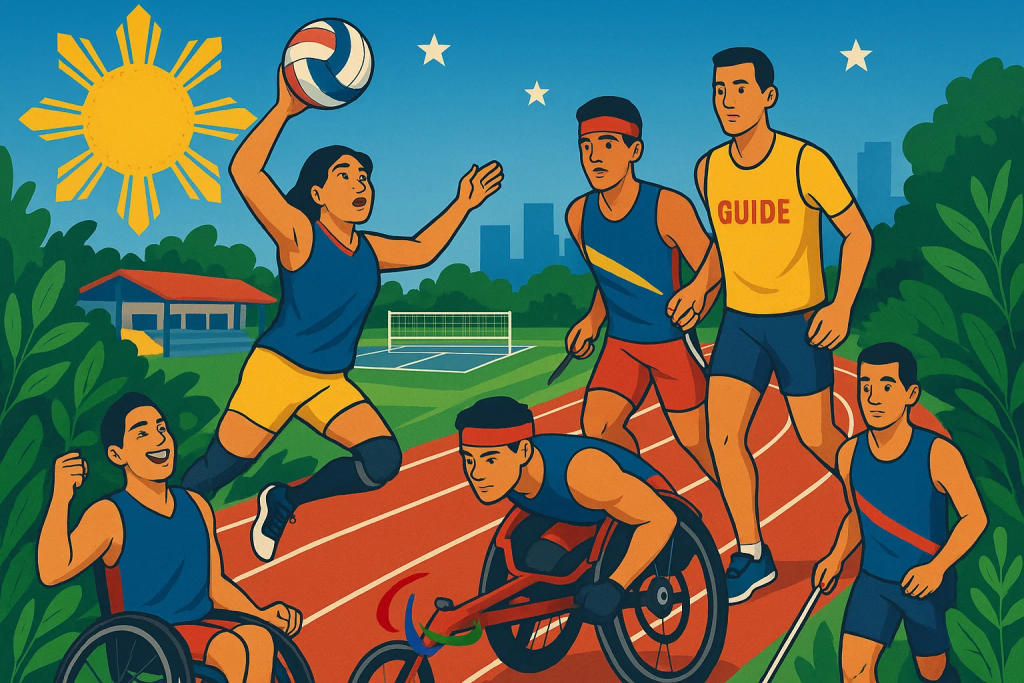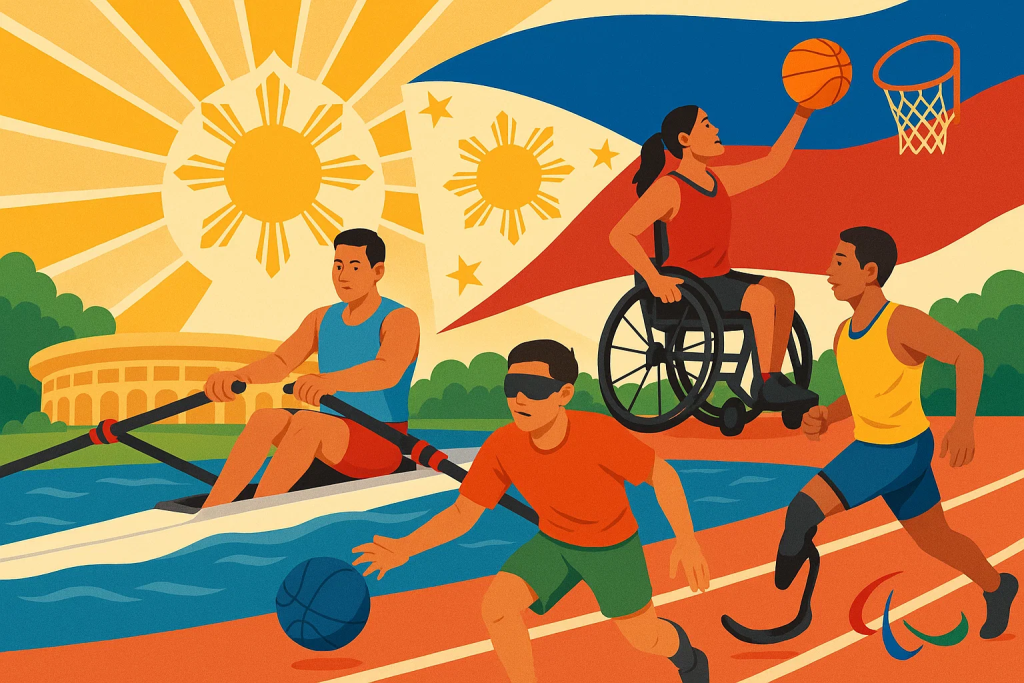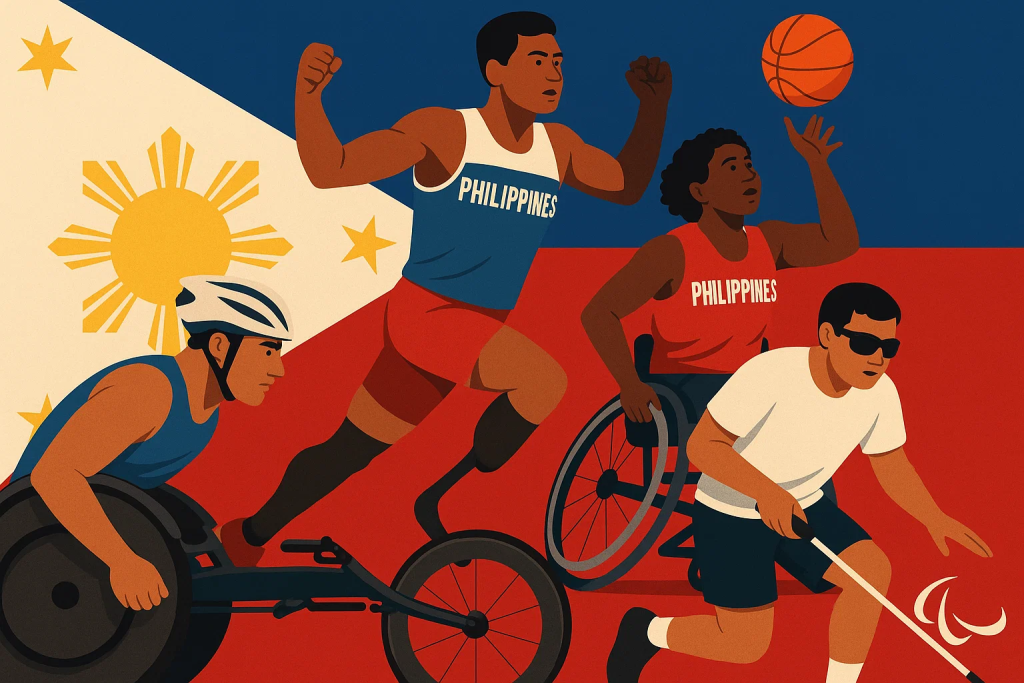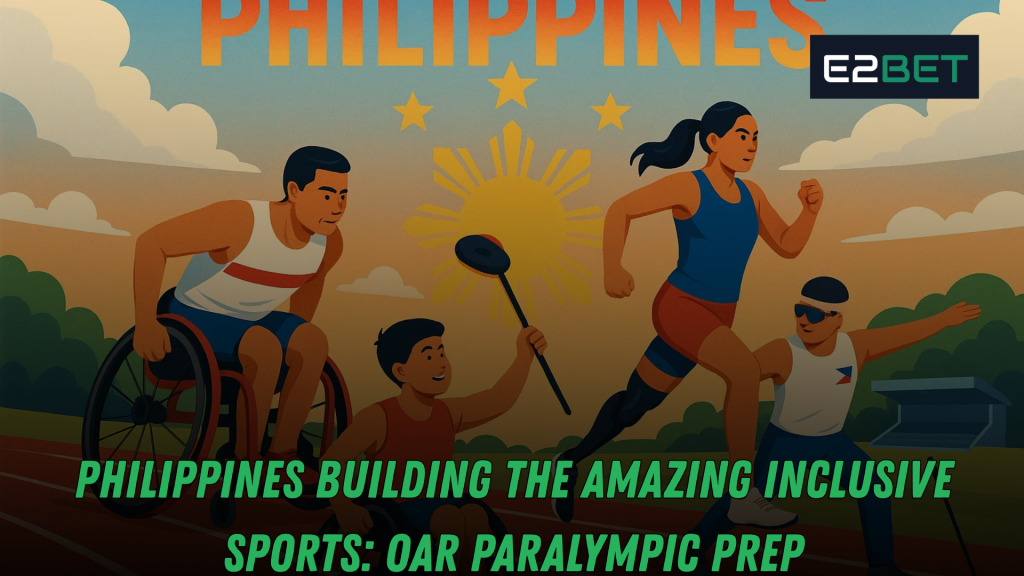Table of Contents
A vision built on dignity, access, and performance
The Philippines is crafting a long-term blueprint to make sport truly welcoming for every body and every mind. In this context, inclusive sports is not a slogan; it is a measurable commitment to remove barriers, nurture talent, and celebrate achievement across disability classifications, genders, ages, and socioeconomic backgrounds. This guide lays out a practical playbook for policymakers, local government units (LGUs), school administrators, coaches, and community organizers who want to convert big promises into daily practices before, during, and after the Paralympic cycle. You’ll find frameworks, checklists, and sample calendars you can copy and paste—plus a clear call to action at the end.

The OAR framework (Outreach, Access, Readiness)
To turn ideals into routines, stakeholders can follow the OAR framework—Outreach, Access, Readiness. The trilogy translates values into actions that scale nationwide while staying personal for each athlete. In doing so, inclusive sports becomes the backbone of a movement rather than a side program.
- Outreach: Find communities, listen to needs, and co-design opportunities with families and local leaders.
- Access: Remove physical, financial, and social barriers across every rung of the pathway.
- Readiness: Prepare athletes, coaches, and systems for high-performance demands with evidence-based training and care.
Each lever strengthens the others. Outreach builds trust, Access builds participation, and Readiness builds results. Combined, they produce a culture where inclusive sports thrives in barangay gyms, school leagues, and national training centers.
Outreach: earning the right to be heard
Great programs start by visiting—not merely inviting. In practice, this means mapping underserved barangays; partnering with DSWD workers, school heads, and PWD councils; and hosting listening clinics where families describe daily frictions (transport, time, diet, equipment, stigma). The outcome is a contact list, a calendar, and a set of early wins. Because trust is earned in person, inclusive sports must show up where people already are—church courtyards, covered courts, and seaside promenades—before asking them to travel or enroll.
Key outreach actions include:
- Launch Community Open Days with free trials of sport chairs, goalball eye shades, or adapted badminton so newcomers feel safe to say “yes.”
- Run Parent Nights that teach basics on physiology, nutrition, and classification—without jargon or pressure.
- Train Barangay Ambassadors—local leaders who can explain how inclusive sports adds pride, belonging, and even livelihood to their communities.
- Offer Try-Three passes: three beginner sessions with transport vouchers to break the “first-mile” barrier.
Outreach succeeds when people feel seen, when communication uses the local language, and when feedback loops are fast. It’s also where inclusive sports programs learn to avoid avoidable mistakes—like scheduling over therapy sessions or ignoring the cost of snacks and water.
Access: removing obstacles one system at a time
Access is the hard work of editing out every unnecessary burden. Public transport should have practical priority seating; ramps must match chair dimensions; ticket counters need sign-language support; and school schedules should avoid pitting therapies against training. Municipalities can create micro-grant queues so a coach can buy grip tape or an athlete can repair a prosthesis within 72 hours. These details are what make inclusive sports real instead of rhetorical.
Practical tactics:
- Built environment: Follow universal design principles for toilets, locker rooms, seating, and sightlines.
- Equipment pools: Centralize sport chairs, blades, frames, and safety gear; rotate monthly across hubs.
- Fee relief: Provide means-tested subsidies and travel vouchers with simple forms in Filipino and regional languages.
- Safeguarding: Enforce background checks, clear reporting routes, and quiet spaces—because inclusive sports is safest when it is accountable.
Access also includes communication access. Publish schedules with large fonts and clear icons, add captions to videos, and keep WhatsApp/Viber groups active for quick updates. When the logistics are simple, the courage to try increases.
Readiness: turning participation into performance
Readiness converts opportunity into results. Coaches need disability-specific pedagogy, classification literacy, and the habit of individualizing plans. Strength and conditioning must account for energy expenditure differences, thermoregulation, and asymmetries. Sports science teams should build testing batteries that are rigorous yet humane. As readiness grows, inclusive sports produces repeatable success: consistent personal bests, resilient habits, and medal-class composure under travel stress and crowd noise.
Readiness pillars:
- Coaching education: Modular courses on impairment-informed cues, chair skills, taping, and warm-up progressions.
- S&C protocols: Microdose speed and power; use injury-prevention ladders for shoulders, trunk stability, and residual-limb health.
- Recovery systems: Standardize mobility work, hydrotherapy when possible, sleep hygiene, and culturally familiar nutrition—lugaw, saba, monggo.
- Performance analytics: Track a five-metric dashboard (readiness score, load, health, skill execution, mood) that flags risk early and keeps inclusive sports both competitive and caring.
The Philippine pathway: from barangay to big stage
A healthy pipeline starts small and nearby. Barangay clinics feed district meets; district standouts join regional hubs; hubs hand promising athletes to national centers. At every rung, responsibilities shift: barangays emphasize fun and safety, regions stress repetition and basic classification literacy, and the national team emphasizes reliability under pressure. The result is a ladder where inclusive sports is visible during weekend fun runs and on primetime broadcasts.
A sample 12-month calendar
- Q1: Open Days, beginner screenings, and family orientations.
- Q2: Regional camps and school festivals; coach shadowing and mentorship.
- Q3: National qualifiers; classification reviews; sport-specific testing.
- Q4: International tournaments; debrief roadshows; coach recertification.
Facility design: more than ramps
True access is not a ramp at the back; it’s a front door that says “you belong.” Architects can specify wide corridors, anti-glare floors, tactile wayfinding, and quiet rooms for sensory breaks. Coaches can zone floors so athletes share space with dignity: lifting bays that allow transfers, hydration points at reach height, and charging stations for chairs and blades. Done well, inclusive sports facilities become neighborhood landmarks that serve both training and community life.
Checklist for accessible facilities:
- Door widths ≥ 900 mm; turning circles ≥ 1500 mm.
- Adjustable benches and transfer-friendly plinths.
- Visual alarms paired with audio cues; high-contrast signage.
- Family change rooms; gender-inclusive options with proper safeguarding.
- Storage for chairs, walkers, and frames—no more “park it in the corridor.”
Coaching for difference: pedagogy that respects bodies
Great coaching notices what the body can do today and expands it by one safe step—that is the heart of inclusive sports coaching. Clear cues (“press the wheel and breathe out”), contact-appropriate spotting, and flexible drills allow mixed-impairment groups to work together without anyone feeling like a burden. The trick is to coach intentions (balance, acceleration, rhythm) instead of fetishizing one visual form.
Example tools:
- Constraint-led games that improve chair angles or stride shapes without overtalking.
- Communication menus with visual cards for pain, fatigue, or heat.
- Buddy systems that pair veterans with newcomers in the same classification family.
- Progression grids that show “good–better–best” options so athletes can choose the right challenge on any day.
Classification literacy: fairness as a skill
Confusion about classification breeds anxiety. A short explainer during intake—what it is, who conducts it, and how appeals work—defuses rumor mills. Teams can appoint a Classification Liaison who keeps records, books reviews, and sets expectations. Normalizing the process keeps inclusive sports focused on performance, not paperwork. The principle is simple: compete where your impairment is fairly represented, then let skill decide.
Sports medicine and mental health: two sides of one coin
Paralympic prep fails when athletes feel like body parts on a spreadsheet. Integrate mental skills from day one—breathwork, self-talk, and micro-resets between reps. Screen for RED-S, pressure sores, and shoulder overuse. Culturally sensitive counseling—delivered in Filipino or an athlete’s home language—makes recovery honest and sustainable. In other words, inclusive sports treats health as performance technology, not as an optional benefit.
Technology that actually helps
Shiny gadgets are pointless if they add friction. Pick tech that saves time or pain: QR codes for attendance, WhatsApp groups for transport coordination, captioning for video reviews, and simple sensors for load monitoring. Upload drill libraries so coaches can search by impairment, not just by sport. When technology trims logistics, inclusive sports staff can spend their best energy on coaching and care.
Funding and governance: boring but decisive
Budgets express priorities. Instead of one-off ribbon cuttings, create multiyear lines for equipment pools, coach stipends, and essential travel. Build a governance model where athletes vote on decisions that affect them. Publish dashboards so donors see where pesos go. Accountability is not a PR chore; it is the social contract that keeps inclusive sports trusted when politics change.
Storytelling that dignifies
Media shapes memory. Shift highlight reels from “overcoming tragedy” to “ordinary excellence.” Use Tagalog or regional-language captions and describe tactics, not just tears. Invite athletes as co-hosts and analysts. When fans learn how a pick-and-roll works in wheelchair basketball or why a sprinter chooses a particular blade stiffness, inclusive sports graduates from charity to craft—and fandom deepens.

The 120-day accelerator (template you can run)
For LGUs, schools, or clubs that want to start fast, here’s a sprint plan that balances ambition and safety.
Days 1–30: Listen and map
- Stakeholder audit: athletes, families, therapists, transport drivers, school heads.
- Facility walk-through: doors, ramps, toilets, storage, emergency routes.
- Quick wins: repair a ramp, add a handrail, buy two adjustable benches.
Days 31–60: Teach and equip
- Coach clinics on impairment-informed pedagogy.
- Starter kit: tape, sliders, gloves, straps, transfer boards.
- Parent sessions on nutrition, sleep, and safeguarding.
Days 61–90: Test and refine
- Mini-league with mixed classifications; debrief with athletes.
- Classification info session; appoint the Liaison.
- Publish a simple code of conduct for inclusive sports and train volunteers.
Days 91–120: Scale and celebrate
- Add two new sites; rotate the equipment pool.
- Shoot explainer videos; broadcast in local language.
- Report to donors: what changed, what remains, what’s next.
KPIs that matter (and that busy teams can track)
What gets measured gets mended. Track:
- Enrollment by classification, age, and gender.
- Weekly session attendance and coach-to-athlete ratios.
- Injury rates per 1000 training hours.
- Retention from Q1 to Q4 (especially for new participants).
- Competitive outcomes (PBs, finals made) and non-competitive outcomes (school attendance, employment status).
Review these five each month. You’ll improve inclusive sports without needing a new slogan
Risk management: humility on paper, safety on the ground
Risk registers sound corporate, but they prevent harm. Identify heat illness, transport delays, safeguarding breaches, and equipment failures; assign owners and mitigations; rehearse drills. Publish a “Stop Card” rule so any coach or athlete can pause a session without punishment. That is how inclusive sports keeps its most fragile promise: safety first, pride always.
Case snapshots (hypothetical but realistic)
- Bohol Swim Hub: A municipal pool added ramp rails, set early-morning quiet hours, and trained two lifeguards in assisted entries. Within one quarter, attendance doubled, and three teens registered for their first meet—proof that inclusive sports scales on small, thoughtful changes.
- Quezon City Chair Basketball: A school gym replaced metal thresholds with bevels and created a chair-rotation pool. Fouls dropped, speed rose, and parents began volunteering as table officials. Saturdays are now a regular celebration of inclusive sports in the district.
- Davao Multi-Sport Saturdays: A park runs open circuits—throws, sprints, and dance cardio—so families exercise together. Local PTs rotate pro bono. Because the vibe is joyful, inclusive sports here looks like a picnic with purpose—and that matters.
The economics of inclusion: why budgets and businesses should care
Every peso invested in accessibility returns value multiple times over. Facilities that welcome a wider range of bodies stay busy for longer hours; events with better logistics attract families who spend on food, transport, and merchandise; and schools that integrate disability sport often report stronger attendance and classroom focus. Employers notice the spillovers: athletes arrive on time, manage energy well, follow instructions precisely, and collaborate under pressure. Multiply these effects and a city begins to see a civic dividend—improved public health, lower dropout rates, and higher confidence in local institutions. In this way, inclusive sports turns from a cost center into a regional development strategy.
A simple rule of thumb can guide decisions: spend first on the boring things that help the most people—ramps, toilets, shade, water, and travel vouchers. If budget remains, upgrade equipment pools and coach stipends. Only after the basics hum should a program chase elite bells and whistles. The lesson shows up again and again: momentum lives in small details you can scale next week, not in one-off purchases no one knows how to maintain. Procurement teams can reinforce this logic with templates that favor durability, repairability, and local service networks—practical ingredients for inclusive sports that lasts.
Volunteers and guardians: the human perimeter
Programs thrive when parents, teachers, and neighbors know what “good” looks like and are invited to help. Create a volunteer ladder with clear entry points: greeters at the gate, hydration monitors, equipment librarians, safeguarding marshals, and shadow coaches. Offer micro-trainings that fit into thirty minutes before practice, with laminated checklists people can pocket. When adults share the same safety language—where to stand during transfers, what to do during heat spikes, how to log a bruise—athletes relax and coaches coach. Over time, this human perimeter becomes a neighborhood tradition that protects inclusive sports far better than posters ever could.
Recognition matters. Post “thank-you boards,” rotate shoutouts on social media, and nominate marshals for barangay awards. Run an annual “guardian night” where families receive short updates on outcomes, budgets, and plans. When helpers feel seen, they keep showing up. That consistency is the quiet superpower of welcoming sport, because predictable adults make predictable safety—and predictable safety makes magical effort possible.
Climate, heat, and the Philippine calendar
Heat is not a footnote; it is a central training variable. Schedule sessions at cooler hours; set a heat policy with red–amber–green thresholds posted at the entrance; and stock call rooms with cold towels. Hydration should be scheduled, not suggested, and coaches must model drinking habits. Typhoon season demands backups: indoor corridors for chair skills, online video sessions for mental skills, and transport alert groups that make cancellations quick and clear. Treating climate as a first-class design constraint prevents last-minute scrambles and helps inclusive sports keep rhythm year-round.
Hosting events the right way
Great meets start months before the opening whistle. Publish eligibility and classification guidance early; hold a rehearsal day for volunteers; walk the route with wheelchair users; and assign a single “problem phone” anyone can call. On race day, make arrival obvious: wide lanes, friendly arrows, hydration on both sides of the hall, and a quiet room near the medical tent. Place shade and seating where families actually gather, and avoid long silent waits by running short emcee segments that explain rules and spotlight first-timers. Afterward, send a two-question survey: “What helped you most?” and “Where did you struggle?” The answers are your next month’s upgrade plan—this is how inclusive sports improves at the speed of community feedback.
International collaboration without losing local flavor
Partnerships with global federations, universities, and NGOs accelerate learning, but the best imports respect local context. Translate manuals, adapt drills to smaller spaces, and use familiar foods for recovery snacks. Ask visiting coaches to teach two things they’re great at and to learn two things from your community. Reciprocity keeps pride intact and ensures that techniques survive after the plane leaves. Above all, keep decision power close to athletes and coaches; outside expertise should sharpen, not replace, local wisdom. That balance lets inclusive sports blossom without becoming an imitation of someone else’s system.
Value beyond medals
Medals inspire, but the bigger dividend is social: confident kids who sleep better, families who make friends across barangays, and coaches who become neighborhood problem-solvers. Employers notice punctuality and teamwork. Therapists see gains that stick because joy sustains repetition. When a city commits to inclusive sports, it invests in public health, civic pride, and disaster resilience—healthy bodies evacuate faster, carry more, and recover better.
Myths and gentle corrections
- Myth: “We need expensive gear to start.”
Reality: One adjustable bench, one transfer board, and a repaired ramp can launch dozens of sessions. That’s how inclusive sports usually begins. - Myth: “Only specialists can coach.”
Reality: Generalist PE teachers can learn impairment-informed cues in a weekend clinic and become excellent allies to inclusive sports. - Myth: “Classification is just politics.”
Reality: It’s an evidence-based process with clear appeals. Transparency reduces noise so inclusive sports can focus on training.
The road to the next Games
Paralympic cycles are four years, but habits are daily. The real work is steady: quieter pool entries, cleaner chair bearings, a coach who texts a reminder to drink water. Stack these habits for 1,000 days and the Games feel less like a miracle and more like a milestone. That is the promise of inclusive sports: better Tuesdays that add up to brilliant Sundays.

Call to action
If you’re an athlete, take the first step—message a local club today.
If you’re a coach, host a free clinic this month and share your slides openly.
If you’re an LGU officer, repair one ramp this week and post the before/after.
If you’re a donor, fund boring essentials: travel, tape, and time.
If you’re a fan, show up and clap.
The Philippines can build a world-class model where inclusive sports is not a headline; it’s simply the way we do things now.
Frequently Asked Questions (FAQ)
1) What is the fastest way a school can start a program?
Begin with a two-hour audit of doors, toilets, and storage; repair one barrier; borrow or rent a small equipment kit; and schedule a Saturday pilot. Announce the plan in Filipino and English with photos. Momentum is the secret fuel of inclusive sports.
2) How can small municipalities fund equipment?
Pool purchases across districts and rotate kits monthly; ask local businesses to sponsor consumables; and apply for national micro-grants. Publish receipts online. Trust grows, and inclusive sports sustains itself rather than fading after one event.
3) What should coaches learn first?
Learn how impairments influence cueing and fatigue, how to scale drills, and how to track readiness without shaming. Keep sessions short, crisp, and joyful—because culture is the competitive edge of inclusive sports.
4) How do families fit training around school and therapy?
Use shared calendars, protect sleep, and minimize transport time by clustering venues near schools. Bring snacks and cooling towels. With routine, inclusive sports becomes the easiest part of the week instead of the hardest.
5) What outcomes should we celebrate besides medals?
Celebrate attendance streaks, new friends, better grades, lower injury rates, and calmer mornings. When you widen what “counts,” more people win—and that is the deepest victory of inclusive sports.
